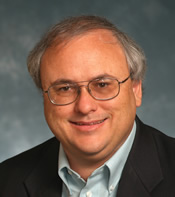Research Interests
The central focus of the Singleton research group is the study of organic, organometallic, and bioorganic reaction mechanisms, and the key tool that we use in these studies is the determination o kinetic isotope effects (KIEs). In the mid-1990's, we developed a method for the high precision combinatorial determination of small KIEs at natural abundance by NMR. Its direct applicability to complex unlabeled reactants makes this methodology 1-2 orders of magnitude faster than studies requiring labeling. At the same time, it is much more versatile - our technique can look at a great number of reactions that would have been impractical or impossible to study by labeling or mass spectral methods, and the choice of reactants can be readily changed in response to each new experimental result. The simultaneous determination of a complete set of 13C, 2H, and 17O isotope effects possible with our methodology provides a much greater level of information than available from conventional methods. In addition, substantial evidence has accumulated supporting the reliable accuracy of our results.
A related advance has been theoretical - the discovery that excellent predictions of KIEs are possible, provided that the calculated transition structure accurately reflects the mechanism. This has allowed us to use KIEs to provide an experimental basis for transition state geometry. The combination of our experimental methodology and theory has repeatedly been successfully applied to resolve controversies, to experimentally establish critical details of important reaction mechanisms, and to find new mechanisms for basic reactions.
The cutting edge in our group is the study of dynamic effects in ordinary reactions in solution. As we have studied reaction mechanisms, we have found that the conventional framework for understanding reactions using transition state theory is often not adequate, and we have found that dynamic effects? play a role in organic reactions much more often than currently thought. In studying such reactions, our goal is to revise the fundamental understanding of reactivity and selectivity in organic chemistry.
Educational Background
- B. S., 1980, Case Western Reserve University
- Ph. D., 1986, University of Minnesota
- NIH Postdoctoral Fellow, 1986-87, University of Wisconsin at Madison
Awards & Honors
- Arthur C. Cope Scholar Award
- Association of Former Students Distinguished Achievement Award for Teaching
Selected Publications
"Controlling Selectivity by Controlling Energy Partitioning in a Thermal Reaction in Solution," Kurouchi, H.; Andujar-De Sanctis, I. L.; Singleton, D. A. J. Am. Chem. Soc. 2016, 138, 14534–14537.
"Dynamics and the Regiochemistry of Nitration of Toluene," Nieves-Quinones, Y.; Singleton, D. A. J. Am. Chem. Soc. 2016, 138, 15167–15176.
"Dynamically Complex [6+4] and [4+2] Cycloadditions in the Biosynthesis of Spinosyn A," A. Patel, Z. Chen, Z. Yang, O. Gutierrez, H. –w. Liu, K. N. Houk, and D. A. Singleton, J. Am. Chem. Soc. 2016, 138, 3631-3634.
"Controlling Selectivity by Controlling the Path of Trajectories," Biswas, B.; Singleton, D. A. J. Am. Chem. Soc. 2015, 137, 14244-14247.
"A Case Study of the Mechanism of Alcohol-Mediated Morita Baylis-Hillman Reactions. The Importance of Experimental Observations," Plata, R. E.; Singleton, D. A. J. Am. Chem. Soc. 2015, 137, 3811-3826.

